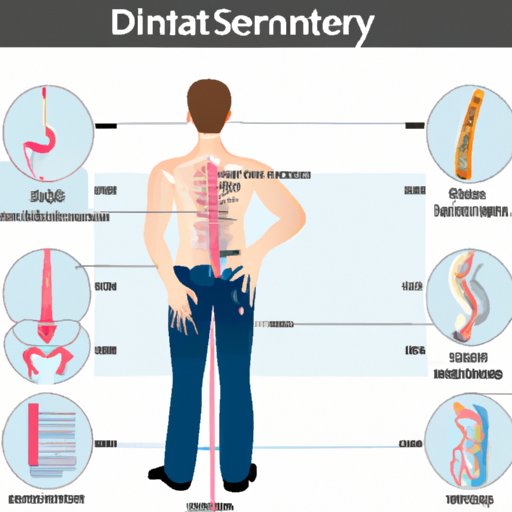
I. Introduction
A herniated disc, also known as a slipped or ruptured disc, is a common spinal injury that can cause discomfort and pain. The spinal column is an essential part of the body responsible for facilitating movement and supporting the body’s weight. This article aims to provide a better understanding of the anatomy of the spine and how a herniated disc may occur.
II. Anatomy of the Spine and Causes of a Herniated Disc
The spine is comprised of 33 vertebrae connected by discs, forming a column that encases the spinal cord. The discs’ primary function is to cushion the vertebrae and ensure flexibility and mobility. A herniated disc can emerge due to natural wear and tear or sudden injury. The wear and tear on the disc could happen due to age. As a person ages, the water content in the discs decreases and makes them less flexible and more vulnerable to tears. An injury or sudden movement can also cause a herniated disc, especially if the movement requires the spine to twist and bend in an unnatural way, such as lifting heavy objects with the back instead of the legs.
Some common examples of how injuries can lead to a herniated disc include car accidents, sports injuries, and falls. It’s also possible to develop a herniated disc due to repetitive motions that lead to wear and tear on the spine over time. For example, people working in jobs that require repetitive movements, such as crouching or lifting, are more prone to developing herniated discs.
III. Risk Factors for Developing a Herniated Disc
Several factors increase the risk of developing a herniated disc, including age, obesity, and physically demanding jobs or sports. As people age, the spinal discs lose water content, making them more prone to tears and injury. Obesity also increases the risk of developing a herniated disc due to the added pressure exerted on the spine. Physically demanding jobs or sports that require repetitive lifting, twisting, or bending motions can also put people at an increased risk of developing a herniated disc.
IV. Symptoms of a Herniated Disc
Symptoms of a herniated disc are sometimes challenging to detect since they may not always manifest. However, the following symptoms are common:
Back pain: Discomfort, soreness, or pain often localized to the back.
Leg pain: Pain that radiates from the lower back to the buttocks, legs, and feet.
Weakness: Muscle weakness, a decrease in motor function, or difficulty performing daily activities.
V. Prevention
Several preventive measures can help avoid a herniated disc. These include maintaining proper posture, exercising regularly, and avoiding heavy lifting or twisting motions. Maintaining proper posture reduces pressure on the spine and helps keep the body balanced. Regular exercise, on the other hand, keeps the muscles and bones healthy and flexible. Lastly, avoiding heavy lifting or twisting motions can reduce the risk of injury to the spine.
VI. Diagnosis of a Herniated Disc
Diagnosis of a herniated disc will involve a physical examination, medical history review, and possible diagnostic tests such as x-rays, MRI scans, and nerve conduction studies. X-rays are a straightforward diagnostic tool that helps identify fractures. MRI and CT scans, on the other hand, can identify soft tissue injuries such as herniated discs. Nerve conduction studies help measure muscle and nerve functionality.
VII. Treatment of a Herniated Disc
Following diagnosis, treatment of a herniated disc depends on the severity of the injury. Treatment options include medication, physical therapy, and surgical intervention. Over-the-counter pain medication and muscle relaxants can help with mild to moderate pain. Physical therapy will help build muscle strength and improve mobility. Surgical intervention may be necessary in severe cases where other treatment options have been ineffective.
VIII. Conclusion
Herniated discs are a common spinal injury, but they can be avoided through proper posture, regular exercise, and avoiding activities that strain the spine. Understanding the anatomy of the spine and the causes of a herniated disc is crucial to attempt to avoid such injuries. If injured, however, early diagnosis and seeking appropriate treatment will help manage the pain and restore mobility.





